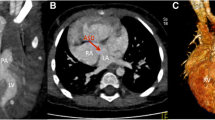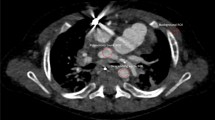Abstract
Background
For coronary artery visualization, retrospective ECG-gated acquisition by dual-source computed tomography (DSCT) was superior to spiral non-ECG-gated acquisition in a paediatric population of congenital heart disease (CHD) patients. However, retrospective cardiac CT is associated with substantial radiation doses to the patient. Recently, DSCT with end-systolic reconstruction was found to be robust for imaging the coronary arteries in patients with high heart rates.
Objective
To evaluate step-and-shoot DSCT with end-systolic reconstruction for evaluating the heart, coronary arteries and other thoracic structures in young children with CHD.
Materials and methods
All neonates and children younger than 6 years of age who were referred to our institution for CHD evaluation between September and October 2009 were included in the study. ECG-gated DSCT was performed in sequential prospective mode centred on the systolic phase identified by ECG analysis. To assess the radiation dose, we recorded the dose-length product (DLP) in mGy·cm and the effective dose in mSv estimated from the DLP. Overall image quality was evaluated using a 5-grade scoring system and was assessed by looking at cardiac and vascular structures. The image quality for the proximal and middle segments of the right and left coronary arteries was also evaluated using a 5-grade scale.
Results
Images of diagnostic quality (grade ≥ 3) were obtained in all 30 children with a mean image quality grade of 4.7 ± 0.6 (range, 3–5). Mean DLP was 5.7 ± 4.8 mGy*cm (range, 1–22 mGy cm) and mean effective radiation dose was 0.26 ± 0.16 mSv (range, 0.05–0.8 mSv).
Conclusion
Prospective ECG-gated thoracic DSCT at end-systole usually provides adequate thoracic and coronary artery image quality in neonates, infants and young children with CHD, independent of heart rate. This new method is associated with lower radiation doses compared to previous literature (mean effective dose, 0.26 mSv).


Similar content being viewed by others
References
Westra SJ, Hill JA, Alejos JC et al (1999) Three-dimensional helical CT of pulmonary arteries in infants and children with congenital heart disease. AJR 173:109–115
Lambert V, Sigal-Cinqualbre A, Belli E et al (2005) Preoperative and postoperative evaluation of airways compression in pediatric patients with 3-dimensional multislice computed tomographic scanning: effect on surgical management. J Thorac Cardiovasc Surg 129:1111–1118
Goo HW, Park IS, Ko JK et al (2005) Computed tomography for the diagnosis of congenital heart disease in pediatric and adult patients. Int J Cardiovasc Imaging 21:347–365
Gilkeson RC, Ciancibello L, Zahka K (2003) Pictorial essay.Multidetector CT evaluation of congenital heart disease in pediatric and adult patients. AJR 180:973–980
Bean MJ, Pannu H, Fishman EK (2005) Three-dimensional computed tomographic imaging of complex congenital cardiovascular abnormalities. J Comput Assist Tomogr 29:721–724
Ou P, Celermajer DS, Calcagni G et al (2007) Three-dimensional CT scanning: a new diagnostic modality in congenital heart disease. Heart 93:908–913
Brenner D, Elliston C, Hall E et al (2001) Estimated risks of radiation-induced fatal cancer from pediatric CT. AJR 176:289–296
Willis CE, Slovis TL (2005) The ALARA concept in pediatric CR and DR: dose reduction in pediatric radiographic exams–a white paper conference. AJR 184:373–374
Vock P (2005) CT dose reduction in children. Eur Radiol 15:2330–2340
Ben Saad M, Rohnean A, Sigal-Cinqualbre A et al (2009) Evaluation of image quality and radiation dose of thoracic and coronary dual-source CT in 110 infants with congenital heart disease. Pediatr Radiol 39:668–676
Stolzmann P, Goetti R, Baumueller S et al (2010) Prospective and retrospective ECG-gating for CT coronary angiography perform similarly accurate at low heart rates. Eur J Radiol Jan 14 [Epub ahead of print]
Herzog BA, Husmann L, Burkhard N et al (2008) Accuracy of low-dose computed tomography coronary angiography using prospective electrocardiogram-triggering: first clinical experience. Eur Heart J 29:3037–3042
Araoz PA, Kirsch J, Primak AN et al (2009) Optimal image reconstruction phase at low and high heart rates in dual-source CT coronary angiography. Int J Cardiovasc Imaging 25:837–845
Bastarrika G, De Cecco CN, Arraiza M et al (2008) Dual-source CT for visualization of the coronary arteries in heart transplant patients with high heart rates. AJR 191:448–454
Adler G, Meille L, Rohnean A et al (2009) Robustness of end-systolic reconstructions in coronary dual-source CT angiography for high heart rate patients. Eur Radiol Nov 5 [Epub ahead of print]
Thomas KE, Wang B (2008) Age-specific effective doses for pediatric MSCT examinations at a large children’s hospital using DLP conversion coefficients: a simple estimation method. Pediatr Radiol 38:645–656
Westra SJ, Hurteau J, Galindo A et al (1999) Cardiac electron-beam CT in children undergoing surgical repair for pulmonary atresia. Radiology 213:502–512
Paul JF, Lambert V, Losay J et al (2002) Three-dimensional multislice CT scanner: value in patients with pulmonary atresia with septal defect. Arch Mal Coeur Vaiss 95:427–432
Khatri S, Varma SK, Khatri P et al (2008) 64-slice multidetector-row computed tomographic angiography for evaluating congenital heart disease. Pediatr Cardiol 29:755–762
Goo HW, Park IS, Ko JK et al (2005) Visibility of the origin and proximal course of coronary arteries on non-ECG-gated heart CT in patients with congenital heart disease. Pediatr Radiol 35:792–798
Tsai IC, Lee T, Chen MC et al (2007) Visualization of neonatal coronary arteries on multidetector row CT: ECG-gated versus non-ECG-gated technique. Pediatr Radiol 37:818–825
Paul JF, Abada HT, Sigal-Cinqualbre A (2004) Should low-kilovoltage chest CT protocols be the rule for pediatric patients? AJR 183:1172, author reply 1172
Paul JF, Abada HT (2007) Strategies for reduction of radiation dose in cardiac multislice CT. Eur Radiol 17:2028–2037
Goo HW, Suh DS (2006) Tube current reduction in pediatric non-ECG-gated heart CT by combined tube current modulation. Pediatr Radiol 36:344–351
Frush DP, Yoshizumi T (2006) Conventional and CT angiography in children: dosimetry and dose comparisons. Pediatr Radiol 36:154–158
Lee T, Tsai IC, Fu YC et al (2006) Using multidetector-row CT in neonates with complex congenital heart disease to replace diagnostic cardiac catheterization for anatomical investigation: initial experiences in technical and clinical feasibility. Pediatr Radiol 36:1273–1282
Kroft LJ, Roelofs JJ, Geleijns J (2010) Scan time and patient dose for thoracic imaging in neonates and small children using axial volumetric 320-detector row CT compared to helical 64-, 32-, and 16- detector row CT acquisitions. Pediatr Radiol 40:294–300
Author information
Authors and Affiliations
Corresponding author
Rights and permissions
About this article
Cite this article
Paul, JF., Rohnean, A., Elfassy, E. et al. Radiation dose for thoracic and coronary step-and-shoot CT using a 128-slice dual-source machine in infants and small children with congenital heart disease. Pediatr Radiol 41, 244–249 (2011). https://doi.org/10.1007/s00247-010-1804-6
Received:
Revised:
Accepted:
Published:
Issue Date:
DOI: https://doi.org/10.1007/s00247-010-1804-6




